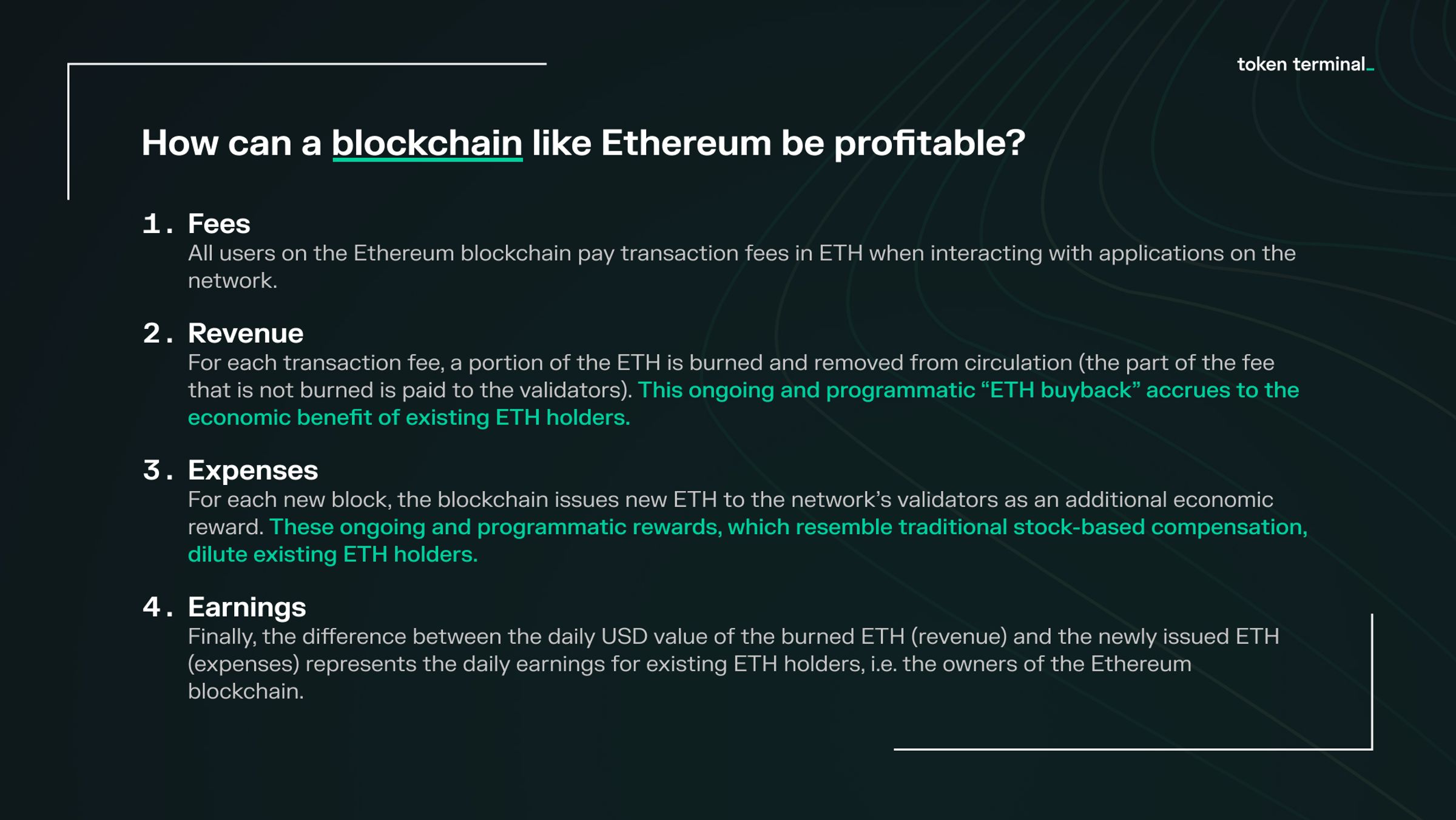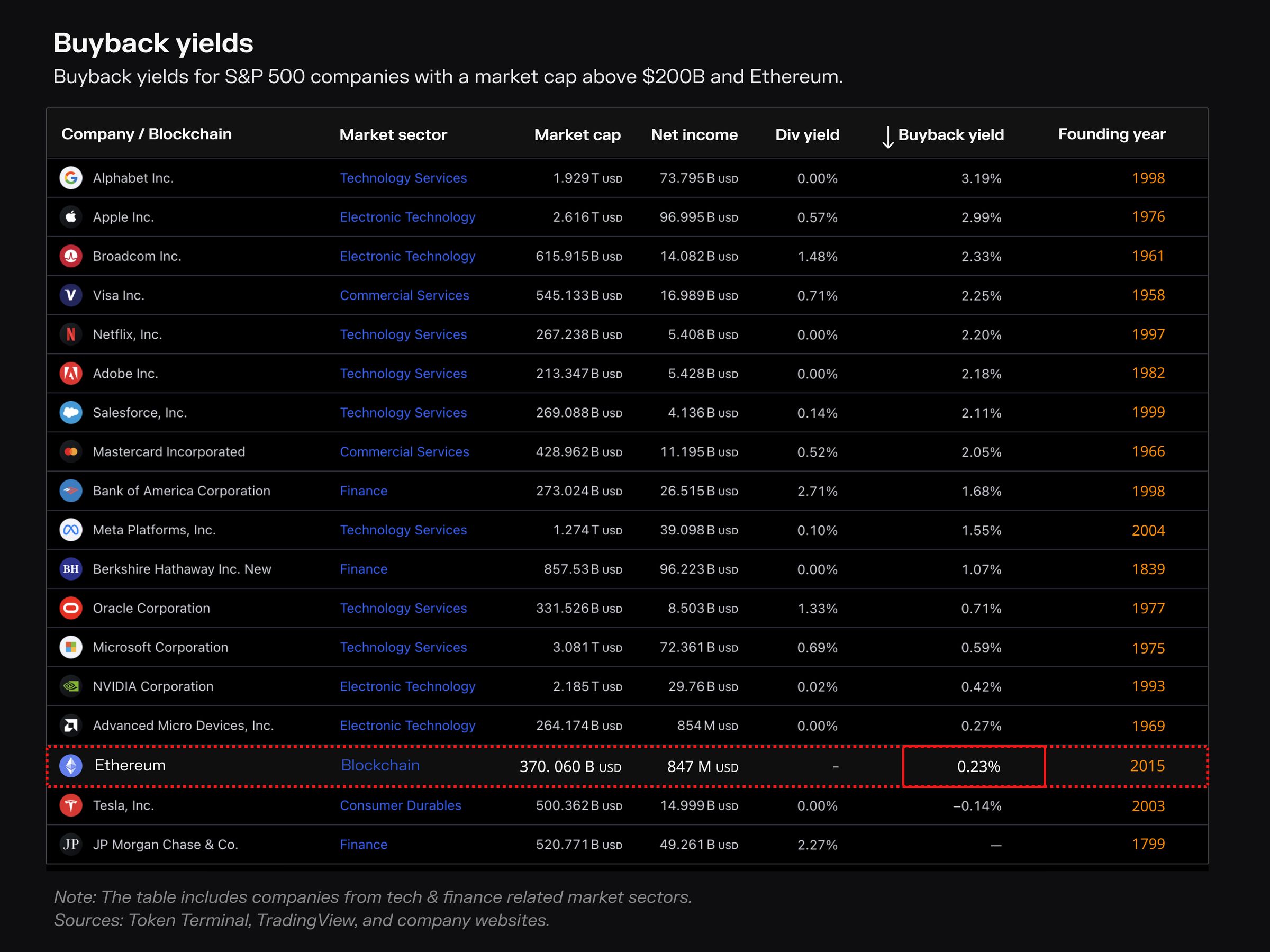- Token Terminal
- Posts
- Ethereum – The “Dividend” King of Crypto
Ethereum – The “Dividend” King of Crypto
This week's newsletter dives into the economics of Ethereum. We provide a step-by-step explanation of how the Ethereum network is able to turn a profit.

Introduction
This week's newsletter dives into the economics of Ethereum. We provide a step-by-step explanation of how the Ethereum network is able to turn a profit. Further, we take a look at how Ethereum benchmarks against some of the leading financial services and technology companies in terms of dividend and buyback yields – two profit distribution-related metrics that are well-known in traditional finance, but rarely talked about in crypto.
Let’s dive in!
1. Ethereum Is a Profitable Blockchain
As a blockchain, Ethereum’s core business model is to sell blockspace to users in exchange for transaction fees. Since The Merge in September 2022, Ethereum has been able to charge higher transaction fees (higher revenue) and share less of the economics with the network’s validators (lower expenses). As a result, the Ethereum blockchain currently operates at a profit (higher earnings). In Q1 ‘24, Ethereum made a profit of $369.08 million.

Monthly earnings for Ethereum since 2018.

An overview of how a blockchain like Ethereum makes money.
2. Investors Do Care About Profitability and Cash Flow
Starting out, a company tends to put all effort into getting users. Once a company has users, it needs to figure out how to charge them to generate revenue. Finally, once a company matures, it tends to focus more on the cost structure and how to make sure that expenses do not exceed the revenues. When revenues exceed costs, the company is able to turn a profit.
A profitable company has two options:
reinvest the earnings back into the business to boost growth, or
distribute the earnings to shareholders.
Should a company decide to distribute the earnings to its shareholders, it can do it in two ways:
pay out the income as a dividend, or
conduct a share buyback and reduce the outstanding amount of shares.
In the former option, the investors earn a steady stream of income from the company, and in the latter, they get to benefit in the form of higher capital gains, as the reduced supply drives up the stock price.
There are two metrics that are widely used in TradFi to assess how much a company pays out to its shareholders:
Dividend yield: how much does a company pay out in dividend relative to its market capitalization? If a company is worth $100M and pays out $1M in dividends, the dividend yield equals 1%.
Buyback yield: to what extent does the company use its retained earnings to buy back the company’s own stock? If a company is worth $100M and uses $1M of its earnings to buy back its own shares, the buyback yield equals 1%.

Ethereum ranks among the top 20 companies globally in terms of buyback yield.

The Ethereum network is only 9 years old, whereas the median age of the other companies on the list is 44 years.
3. Ethereum Lays Out a Path Forward for Blockchain-Based Businesses
Ethereum has a buyback yield of 0.23%, which means that the net income (earnings) it generated over the past 12 months – which was paid out in full to ETH holders through the fee burn mechanism – represents 0.23% of the network’s total market cap. In comparison, an established “protocol” like Visa, was able to pay out 0.71% of its market cap in dividends, and on top of that, buy back VISA shares to an amount that equals 2.25% of its $545.13 billion market capitalization.
It’s worth highlighting that the Ethereum network is only 9 years old, whereas the median age of the other S&P 500 companies on the list is 44 years. This goes to show how scalable (and profitable) Internet-native, blockchain-based businesses can be at best.
Ethereum is an outlier in terms of performance within the crypto market, but at the same time, also an example of what kind of growth is possible for the top performers in crypto. We believe that most entities on this list will be blockchain-based businesses in 10 years.
Relevant links:
Real-time onchain financials for Ethereum: https://tokenterminal.com/terminal/financial-statements/ethereum
Real-time onchain financials for Bitcoin: https://tokenterminal.com/terminal/financial-statements/bitcoin
Real-time onchain financials for Solana: https://tokenterminal.com/terminal/financial-statements/solana
📣 Insights from our community
Data-driven insights from analysts using Token Terminal PRO
"But perhaps the best kept secret about $ETH is that it has real, investable economics"
— Token Terminal (@tokenterminal)
5:49 PM • Apr 9, 2024
🚨 BREAKING: The Ethereum blockchain generated a $369.08M profit in Q1 ‘24.
Wait, what?!
How can a *blockchain* like @ethereum be profitable?
Let's go through Ethereum's business model step-by-step:
1. Fees. All users on the Ethereum blockchain pay transaction fees in ETH… twitter.com/i/web/status/1…
— Token Terminal (@tokenterminal)
10:50 AM • Apr 18, 2024
At the end of the day, the winners will be:
1. The fast-moving incumbents (such as @BlackRock)
2. The public blockchains that issue and settle the assets.Don't overthink it.
Data: Blackrock's BUIDL money market account on Ethereum ($288m AUM currently) — powered by… twitter.com/i/web/status/1…
— Michael Nadeau (@JustDeauIt)
5:27 PM • Apr 12, 2024